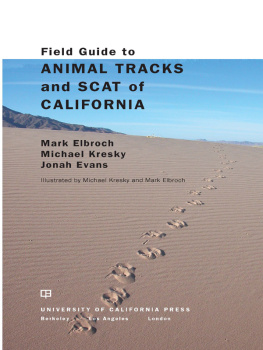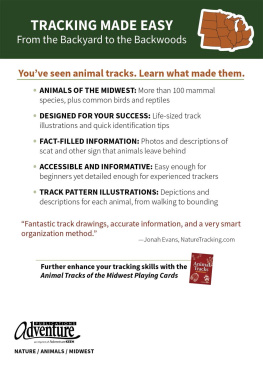ABOUT THE AUTHORS
Mark Elbroch is author of numerous guides to wildlife tracking, including the award-winning Mammal Tracks and Sign: A Guide to North American Species and Bird Tracks and Sign: A Guide to North American Species. Mark was awarded a Senior Tracker Certificate by CyberTracker Conservation (www.cybertracker.org) in South Africa, the 17th given in more than 10 years of testing wildlife trackers, and the first awarded to a non-African. He carried the CyberTracker Tracker Evaluation system to North America, where it has been used to test observer reliability in wildlife projects and as an educational tool for varied institutions. Mark works as a biologist with a current focus on Pumas. His dissertation work at the University of California, Davis focused on the feeding ecology of Patagonia Pumas. He maintains the website http://wildlifetrackers.com.
Michael Kresky studied philosophy and art at Jacksonville University in Florida and then completed a teaching credential at UC Santa Barbara. He is a professional artist and professional natural historian, with specializations in wildlife tracking and native plants; he has taught natural history courses in venues as diverse as home school programs to university courses. Michael was tested and awarded a Track and Sign Specialist Certificate from CyberTracker Conservation in the woods he knows so well near his home in Santa Barbara (scoring higher than 100%!).
Jonah Evans currently lives in far west Texas working as a Non-game Biologist for Texas Parks and Wildlife conducting wildlife research on a variety of species. Jonah received an M.S. in Wildlife Science from Texas A&M University where he studied issues of observer reliability in a Texas Parks and Wildlife river otter track survey. He was tested in southern California and awarded a Track and Sign Specialist Certificate by CyberTracker Conservation, and then went on to learn and contribute to the system as an Evaluator. Jonah has worked on numerous wildlife projects, studying Lynx, river otter, Fisher, goshawk, elk, Black-tailed Prairie Dogs, and Golden-cheeked Warblers; he continues to work toward improving the tracking skills of biologists and the effectiveness of tracking-based research methods. Jonah maintains the website http://naturetracking.com.
ACKNOWLEDGMENTS
We would like to thank the production team at UC Press for their enthusiasm, patience, and attention to detail. Thank you to Anne Hawkins for continued support, patience, humor, and deftly negotiating another contract. We'd also like to thank Liz Snair and Alex Huryn, who shared images of mammal tracks and scats, as well as Rick Truex, wildlife biologist for Sequoia National Forest, William J. Zielinski and Ric Schlexer at the Redwood Sciences Laboratory of the USFS Pacific Southwest Research Station, Preston Taylor, Casey McFarland, and Neal Wight for their support and providing us with access to their track plate collections.
While juggling way too much at UC Davis, many have encouraged me and, at times, even carried me: Heiko Wittmer, Jacob Katz and Kendra Johnson, Bjorn Erickson and Lisa Matsubara, Allison Olliver, Jen Hunter, Maria Santos, Katie Fleer, Phil Sandstrom, Marit Wilkerson, and all those others faithful to Sophia's. Huge thanks to those who support my tracking endeavors: Paul Rezendes, Paulette Roy, Louis Liebenberg, Adriaan Louw, Casey McFarland, George Leoniak, Brian McConnell, Nancy Birtwell, Fred Vanderbeck, and Keith Badger. And last, but not least, thank you to all my family for enduring support and patience.
Mark Elbroch
I'd like to thank Meghan Walla-Murphy, Robbie Olhiser, Stephen Mark Paulsen, Thea Rae Altman, Gary Sieser, Elizabeth Cohen, Preston Taylor, Stephanie Pappas of the Chelonian Science Foundation, the Dautch family, Briggitte Cahill, Arianna Palmisano, Jonathan Weber, and Seston Graham for their support, humor, and generosity in making this book happen.
Michael Kresky
I'd like to thank my wife, Ciel, and our new baby girl, Stella, for supporting my passion for wildlife and tracking.
Jonah Evans
ART CREDITS
Photography by Mark Elbroch, unless otherwise noted
Mammal track and trail illustrations by Mark Elbroch
Mammal feet illustrations by Michael Kresky, excepting Virginia Opossum, American Badger, American Beaver, Hispid Cotton Rat, Brown Rat, and Roof Rat, which were reprinted from The Wild Mammals of Missouri by Schwartz and Schwartz (2002). Used with permission of the University of Missouri Press.
Bird tracks by Mark Elbroch
Bird, reptile, and amphibian feet by Michael Kresky
Insects and their trail illustrations by Michael Kresky
Reptile and amphibian trails by Mark Elbroch
| Series Design: | Barbara Jellow |
| Design Enhancements: | Beth Hansen |
| Design Development: | Jane Tenenbaum |
| Indexer: | Nancy Newman |
| Composition: | P.M. Gordon Associates |
| Text: | 9/10.5 Minion |
| Display: | ITC Franklin Gothic Book and Demi |
| Prepress: | Embassy Graphics |
| Printer and Binder: | Imago |
BIBLIOGRAPHY
Anderson, D. 2001. The need to get the basics right in wildlife field studies. Wildlife Society Bulletin 29:12941297.
Armitage, K. B. 1976. Scent marking by yellow-bellied marmots. Journal of Mammalogy 57:583584.
. 2003. Marmots. In Wild mammals of North America: biology, management, and conservation. 2d ed., ed. G. Feldhamer, B. Thompson, and J. Chapman, 188211. Baltimore: Johns Hopkins University Press.
Arnold, J. F., and H. G. Reynolds. 1943. Dropping of Arizona and antelope jack rabbits and the pellet census. Journal of Wildlife Management 7:322327.
Asa, C. S., E. K. Peterson, U. S. Seal, and L. D. Mech. 1985. Deposition of analsac secretions by captive wolves (Canis lupus). Journal of Mammalogy 66:8993.
Bailey, T. N. 1974. Social organization in a bobcat population. Journal of Wildlife Management 38:435446.
Bang, P., and P. Dahlstrom. 1972. Collins guide to animal tracks and signs, translated and adapted by G. Vevers, 1974. London: Collins Presss.
Barja, I., and R. List. 2006. Faecal marking behaviour in ringtails (Bassariscus astutus) during the non-breeding period: spatial characteristics of latrines and single faeces. Chemoecology 16:219222.
Ben-David, M., R. T. Bowyer, L. K. Duffy, D. D. Roby, and D. M. Schell. 1998. Social behavior and ecosystem processes: river otter latrines and nutrient dynamics of terrestrial vegetation. Ecology 79:25672571.
Ben-David, M., G. M. Blundell, J. W. Kern, J. A. K. Maier, E. D. Brown, and S. C. Jewett. 2005. Communication in river otters: creation of variable response sheds for terrestrial communities. Ecology 86:13311345.
Bowyer, R. T., and D. W. Kitchen. 1987. Significance of scent-marking by Roosevelt elk. Journal of Mammalogy 68:418423.
Brinck, C., R. Gerell, and G. Odham. 1978. Anal pouch secretion in mink Mustela vison. Chemical communication in Mustelidae. Oikos 30:6875.
Burst, T. L., and M. R. Pelton. 1983. Black bear mark trees in the Smoky Mountains. Bears: Their Biology and Management 5:4553.
Byers, J. 2003. Pronghorn. In Wild mammals of North America: biology, management, and conservation. 2d ed., ed. G. Feldhamer, B. Thompson, and J. Chapman, 9981009. Baltimore: Johns Hopkins University Press.
Cahalane, V. H. 1961. Mammals of North America. New York: Macmillan.
Carraway, L. N., and B. J. Verts. 1993. Aplodontia rufa. The American Society of Mammalogists: Mammalian Species No. 431:110.
Next page


